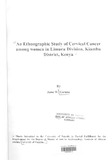| dc.description.abstract | Cervical cancer is the most common form of cancer among women in the developing
countries. In Kenya, it accounts for 59% of all genital cancers of both men and women.
Although it is the most preventable form of cancer, its incidence remains high, with 500,000
new cases occurring annually worldwide. About half of these women die from the disease
annually, at a time when they have' important social and economic responsibilities. The
objective of the study was to assess knowledge, attitudes and preventive behaviour of women
regarding cervical cancer. The Health Belief Model, a theoretical framework used in the
analysis of health related behaviour, guided the study. It is important in explaining as well as
predicting individual acceptance of health care recommendations.
The study was a descriptive, cross-sectional study, carried out in Lirnuru division of
Kiambu district, Kenya. One hundred and sixty women (mean age of 37.9 years) who sought
various services from Tigoni Sub-District Hospital were interviewed. Three Focus Group
Discussions (FGDs) were conducted and five case narratives recorded.
Two-fifths (40%) of the respondents reported having heard about cervical cancer.
About a third (33%) spontaneously associated cervical cancer with contraceptive use, notably
use of pills and coils. Having multiple sexual partners (5l.2%) and a history of STDs (6l.5%)
were other risk factors mentioned by respondents. Less than half (45.2%) who had heard
about cervical cancer reported that it could be prevented. Various barriers to utilization of
screening services were mentioned including lack of knowledge about Pap smears, lack of
knowledge of where such services are offered, attitude of health service providers, ignorance,
that women do not give it a thought or may~beafraid or embarrassed of pelvic examination,
and that Pap smear examination is expensive. A majority (87.5%) felt vulnerable, since it
affects women, any of them could catch it; reported multiple sexual partners; use of FP; fate
or bad luck; inability to identify andlor avoid risk factors; and unfaithfulness of their sexual
partners (whether real or perceived).
An extensive knowledge base of cervical cancer and its risk factors lacks among
women in Kiambu. Inadequate and misconceived knowledge of cervical cancer, and lack of
awareness of services and their location may be barriers to service utilization by women.
Educational campaigns need to be established. Reproductive health programmes should
promote safer sexual behaviour, as well as incorporate a gender approach, specifically male
involvement in reproductive health, to address gender-related problems that face women | en |

